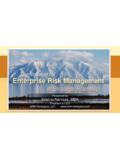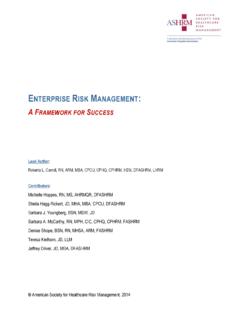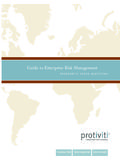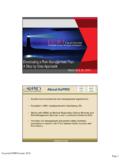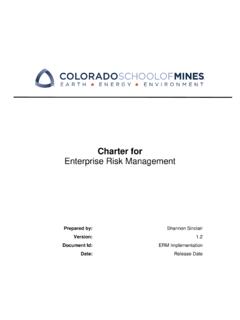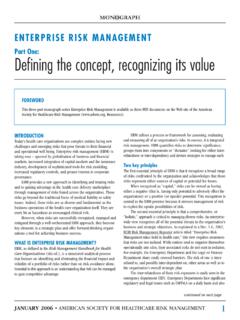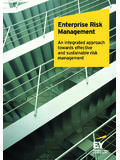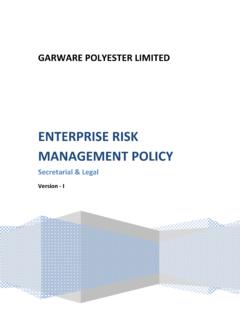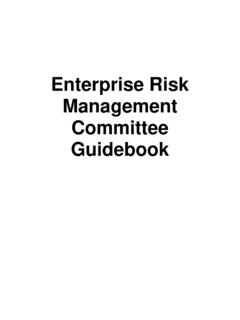Transcription of What is Enterprise risk management? - Nc State University
1 1 REPORTING KEY RISK INFORMATION TO THE BOARD OF DIRECTORSWhat is Enterprise risk management ?2016 Mark S. BeasleyDeloitte Professor of ERM and Director of the ERM InitiativeNorth Carolina State University2801 Founders DriveRaleigh, NC | what IS Enterprise RISK management ? 1 Mark S. Beasley Deloitte Professor of ERM and Director of the ERM Initiative All organizations have to manage risks in order to stay in business. In fact, most would say that managing risks is just a normal part of running a business. So, if risk management is already occurring in these organizations, what s the point of Enterprise risk management (also known as ERM )? Let s Start by Looking at Traditional Risk management Business leaders manage risks and they have done so for decades. Thus, calls for Enterprise risk management aren t suggesting that organizations haven t been managing risks . Instead, proponents of ERM are suggesting that there may be benefits from thinking differently about how the Enterprise manages risks affecting the business.
2 Traditionally, organizations manage risks by placing responsibilities on business unit leaders to manage risks within their areas of responsibility. For example, the Chief Technology Officer (CTO) is responsible for managing risks related to the organization s information technology (IT) operations, the Treasurer is responsible for managing risks related to financing and cash flow, the Chief Operating Officer is responsible for managing production and distribution, and the Chief Marketing Officer is responsible for sales and customer relationships, and so on. Each of these functional leaders is charged with managing risks related to their key areas of responsibility. This traditional approach to risk management is often referred to as silo or stove-pipe risk management whereby each silo leader is responsible for managing or elevating risks within their silo as shown in Figure 1 below. Figure 1 what IS Enterprise RISK management ?
3 2 Limitations with Traditional Approaches to Risk management While assigning functional experts responsibility for managing risks related to their business unit makes good sense, this traditional approach to risk management has limitations, which may mean there are significant risks on the horizon that may go undetected by management and that might affect the organization. Let s explore a few those limitations. Limitation #1: There may be risks that fall between the siloes that none of the silo leaders can see. risks don t follow management s organizational chart and, as a result, they can emerge anywhere in the business. As a result, a risk may be on the horizon that does not capture the attention of any of the silo leaders causing that risk to go unnoticed until it triggers a catastrophic risk event. For example, none of the silo leaders may be paying attention to demographic shifts occurring in the marketplace whereby population shifts towards large urban areas is happening at a faster pace than anticipated.
4 Unfortunately, this oversight may drastically impact the strategy of a retail organization that continues to look for real estate locations in outlying suburbs or more rural areas surrounding smaller cities. Limitation #2: Some risks affect multiple siloes in different ways. So, while a silo leader might recognize a potential risk, he or she might not realize the significance of that risk to other aspects of the business. A risk that seems relatively innocuous for one business unit, might actually have a significant cumulative effect on the organization if it were to occur and impact several business functions simultaneously. For example, the head of compliance may be aware of new proposed regulations that will apply to businesses operating in Brazil. Unfortunately, the head of compliance discounts these potential regulatory changes given the fact that the company currently only does business in North America and Europe.
5 what the head of compliance doesn t understand is that a key element of the strategic plan involves entering into joint venture partnerships with entities doing business in Brazil and Argentina, and the head of strategic planning is not aware of these proposed regulations. Limitation #3: Third, in a traditional approach to risk management , individual silo owners may not understand how an individual response to a particular risk might impact other aspects of a business. In that situation, a silo owner might rationally make a decision to respond in a particular manner to a certain risk affecting his or her silo, but in doing so that response may trigger a significant risk in another part of the business. For example, in response to growing concerns about cyber risks , the IT function may tighten IT security protocols but in doing so, employees and customers find the new protocols confusing and frustrating, which may lead to costly work-arounds or even the loss of business.
6 Limitation #4: So often the focus of traditional risk management has an internal lens to identifying and responding to risks . That is, management focuses on risks related to internal operations inside the walls of the organization with minimal focus on risks that might emerge externally from outside the business. For example, an entity may not be monitoring a competitor s move to develop a new technology that has the potential to significantly disrupt how products are used by consumers. Limitation #5: Despite the fact that most business leaders understand the fundamental connection of risk and return , most businesses are struggling to connect their efforts in risk management to strategic planning. For example, the development and execution of the entity s strategic plan may not give adequate consideration to risks because the leaders of traditional risk management functions within the organization have not been involved in the process.
7 what IS Enterprise RISK management ? 3 The result? There can be a wide array of risks on the horizon that management s traditional approach to risk management fails to see, as illustrated by Figure 2. Unfortunately, some organizations fail to recognize these limitations in their approach to risk management before it is too late. Figure 2 Embracing Enterprise Risk management (ERM) Over the last decade or so, a number of business leaders have recognized these potential risk management shortcomings and have begun to embrace the concept of Enterprise risk management as a way to strengthen their organization s risk oversight. They have realized that waiting until the risk event occurs is too late for effectively addressing significant risks and they have proactively embraced ERM as a business process to enhance how they manage risks to the Enterprise . The objective of Enterprise risk management is to develop a holistic, portfolio view of the most significant risks to the achievement of the entity s most important objectives.
8 The e in ERM signals that ERM seeks to create a top-down, Enterprise view of all the significant risks that might impact the business. In other words, ERM attempts to create a basket of all types of risks that might have an impact both positively and negatively on the viability of the business. Leadership of ERM Given the goal of ERM is to create this top-down, Enterprise view of risks to the entity, responsibility for setting the tone and leadership for ERM resides with executive management and the board of directors. They are the ones who have the Enterprise view of the organization and they are viewed as being ultimately responsible for understanding, managing, and monitoring the most significant risks affecting the Enterprise . Top management is responsible for designing and implementing the Enterprise risk management process for the organization. They are the ones to determine what process should be in place and how it should function, and they are the ones tasked with keeping the process active and alive.
9 The board of director s role is to provide risk oversight by (1) understanding and approving management s what IS Enterprise RISK management ? 4 ERM process and (2) overseeing the risks identified by the ERM process to ensure management s risk-taking actions are within the stakeholders appetite for risk taking. (Check out our thought paper, Strengthening Enterprise Risk management for Strategic Advantage, issued in partnership with COSO, that focuses on areas where the board of directors and management can work together to improve the board s risk oversight responsibilities and ultimately enhance the entity s strategic Elements of an ERM Process Because risks constantly emerge and evolve, it is important to understand that ERM is an ongoing process. Unfortunately, some view ERM as a project that has a beginning and an end. While the initial launch of an ERM process might require aspects of project management , the benefits of ERM are only realized when management thinks of ERM as a process that must be active and alive, with ongoing updates and improvements.)
10 The diagram in Figure 3 illustrates the core elements of an ERM process. Before looking at the details, it is important to focus on the oval shape to the figure and the arrows that connect the individual components that comprise ERM. The circular, clockwise flow of the diagram reinforces the ongoing nature of ERM. Once management begins ERM, they are on a constant journey to regularly identify, assess, respond to, and monitor risks related to the organization s core business model. Figure 3 Positioning ERM for Strategic Value Because ERM seeks to provide information about risks affecting the organization s achievement of its core objectives, the starting point of an ERM process begins with gaining an understanding of what currently drives value for the business and what s in the strategic plan that represents new value drivers for the business. To ensure that the ERM process is helping management keep an eye on internal or external events that might trigger risk opportunities or threats to the business, a 1 Visit our website to download this and the other thought papers highlighted in this document.




